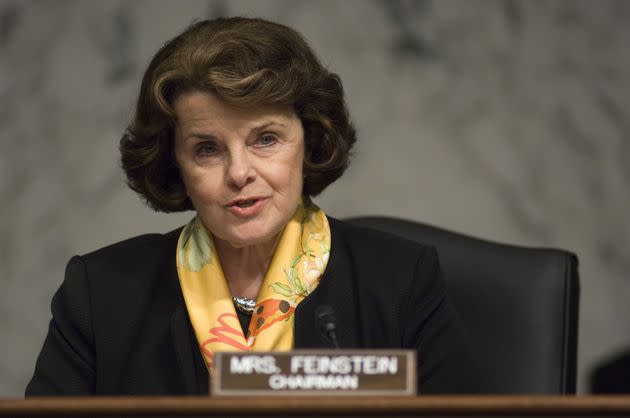Dianne Feinstein’s Fight Against The CIA Made A Difference
- Oops!Something went wrong.Please try again later.
- Oops!Something went wrong.Please try again later.
- Oops!Something went wrong.Please try again later.
In 2009, Dianne Feinstein (D-Calif.) became the first woman to lead the storied Senate Select Committee on Intelligence — just as Barack Obama became the second president to oversee the massively expanded national security establishment that America developed after the 9/11 terror attacks.
Both Democrats had condemned the way President George W. Bush handled security matters, and both particularly opposed the Bush administration’s use of a global detention and interrogation program for suspected terrorists. Feinstein, who died on Friday at age 90, channeled that concern into a years-long battle, defying opponents ranging from Obama’s team to the CIA and its allies. The result was a lasting statement against torture and in favor of accountability.
Feinstein’s unlikely push to reveal the truth about U.S. misconduct in the name of keeping Americans safe is likely to be one of the most consequential elements of her legacy. By producing a 6,700-page report on Bush-era torture — and insisting that a lengthy executive summary be released publicly — she irrevocably changed America’s national security conversation.
A Grueling Battle
Starting soon after Sept. 11, 2001, the CIA began sweeping up supposed plotters of terrorist attacks and held them at secret facilities worldwide. American interrogators, or foreign partners they directed, meted out gruesome tactics the agency called “enhanced interrogation techniques.”
Weeks after Feinstein took over the Intelligence Committee, two members of the committee’s staff told the panel they had reviewed CIA cables showing the agency had subjected detainees to extensive waterboarding and stress positions, as well as threats, near-constant nudity and slaps. The staffers also reported that CIA officials had kept torturing detainees even after they were ready to cooperate or after the officials assessed that the detainees lacked valuable information.
Feinstein was well-known as a supporter of intelligence agencies. But she determined the entire CIA program needed to be probed — and nearly every member of the intelligence committee from both parties agreed with her. The committee began a sprawling inquiry.

Soon after Dianne Feinstein (D-Calif.) took over the Senate Intelligence Committee, she directed the panel to probe the CIA's rendition and interrogation program.
The Obama administration agreed to give Senate personnel access to a huge cache of operational cables, emails and memos related to the detention program, so long as they worked at a CIA office in Virginia rather than transfer material to Capitol Hill. The arrangement was not perfect: On at least two occasions, CIA personnel stopped committee staff from accessing previously provided documents.
Still, by December 2012, the staff finished a report painstakingly dismantling examples the CIA cited as proof that torture had prevented terrorism and exposing new details of the agency’s viciousness, such as its use of “rectal feeding” and sleep deprivation periods of up to a week. Feinstein sent the document to the Obama administration for its response, which the CIA delivered in the summer of 2013, admitting some mistakes but firmly denying the report’s overall conclusions.
Then John Brennan — Obama’s third CIA director and the deputy executive director at the agency from 2001 to 2003, when it was carrying out some of the worst abuses in the rendition program — escalated the dispute. In January 2014, Brennan privately berated Feinstein and the committee’s vice chair, then-Sen. Saxby Chambliss (R-Ga.), over his suspicion that Senate staffers had accessed CIA material they were not entitled to. “John didn’t handle that right,” Chambliss recalled to The New Yorker.
“Brennan has such an explosive temper. His face turns really red. Dianne seems to bring that out in him — because she’s so West Coast, calm, cool, stately,” former Sen. Jay Rockefeller of West Virginia, Feinstein’s predecessor on the committee, told the magazine of the dynamic between the two.
Feinstein said the “terrible” meeting was “something I never expected to see in my government.”
By March, McClatchy News reported that the CIA inspector general was investigating an explosive claim that Brennan’s staff had been monitoring Feinstein’s team. The implication: A national security institution had become so overconfident it was willing to challenge the constitutional separation of powers between the executive branch and Congress.
After weeks of trying to quietly mend the CIA-Senate rift, Feinstein went to the Senate floor to “reluctantly” address it in public. She specifically defended Senate staffers for keeping a copy of a skeptical internal CIA review of the rendition program.
“How can the CIA’s official response to our study stand factually in conflict with its own internal review?” Feinstein asked. She noted that a CIA attorney working under Brennan who had reported her staff to the Justice Department was himself one of the top CIA lawyers involved in the rendition program.
“We’re not going to stop,” Feinstein continued. “How this is resolved will show … whether our work can be thwarted by those we oversee.”
Senate Democrats gave her a standing ovation at a lunch later that day. Appearing on Fox News a few weeks later, former CIA director Michael Hayden cited Feinstein’s speech to launch a sexist assault on her work, saying the remarks showed an “emotional feeling on the part of the senator” that compromised her report.
Brennan ultimately acknowledged the CIA had misstepped in monitoring the Senate committee and apologized to Feinstein that summer.
Feinstein spent most of 2014 trying to publish her report. The White House told her the CIA would lead the process of declassifying the document. When she said that represented a conflict of interest, she got no response. She pushed back against the CIA’s recommended cuts and spent months negotiating with White House chief of staff Denis McDonough over questions like whether the document could include pseudonyms for key figures in the rendition program, which the CIA first said Senate staffers could employ but then claimed would make operatives identifiable.
The tense bargaining process directly pitted Feinstein against the president, her ostensible political ally. “Obama participated in the slowdown process and that’s a hard thing to forgive,” Rockefeller told The New Yorker.

Obama aide John Brennan (left) committed to supporting Feinstein's investigation into the CIA torture program but then spent months challenging the probe and her efforts to release its findings.
By Dec. 5, with Republicans set to take over the Senate within weeks and unlikely to prioritize releasing the report, Feinstein sent the report to be printed. Then-Secretary of State John Kerry — a personal friend — called her to say releasing the document would put America at risk by sparking a backlash. Multiple government agencies publicly made a similar claim in a threat assessment.
Feinstein released the report anyway on Dec. 9, sending the full classified version to government agencies and publishing the executive summary with agreed-upon redactions. In remarks that day, she said: “There are those who will seize upon the report and say ‘See what Americans did,’ and they will try to use it to justify evil actions or to incite more violence. We cannot prevent that.”
“But history will judge us by our commitment to a just society governed by law and the willingness to face an ugly truth and say ‘Never again,’” Feinstein continued.
The executive summary said waterboarding and painful restraints had been more widespread than was known, shed light on the CIA’s efforts to hide its activities from other officials all the way up to the president and emphatically denied any national security benefit of deploying torture. As human rights groups and watchdog organizations commemorated a win for transparency, hawks — including high-profile former intelligence officials — trashed Feinstein for weeks. Rep. Jeff Duncan (R-S.C.) called the veteran senator “a traitor” akin to Edward Snowden.
“They rolled out the big guns,” said then-Sen. John McCain (R-Ariz.), himself a survivor of torture, of the pushback to Feinstein. “I’m proud of her resilience.”
A Lasting Message
Feinstein’s report had an immediate impact for the prospects of the U.S. living up to its stated values.
Because the Senate’s executive summary was the first public detailing of the government’s responsibility for torture, it allowed attorneys representing detainees at Guantanamo Bay to talk in court about what their clients had experienced — helping America’s justice system more fully reckon with the “war on terrorism” era.
Less than a year after the torture report’s release, Congress and Obama approved legislation from Feinstein and McCain reiterating the ban on torturing detainees in U.S. custody and curtailing interrogation techniques that any government agency could use. As a bipartisan statement from two high-profile legislators, the step “made it much more difficult bureaucratically for the U.S. to engage in any kind of systematic torture program ever again,” said Andrea Prasow, an activist who spent years working on anti-torture advocacy at Human Rights Watch.
In the following years, Feinstein continued challenging defenders of torture and people involved in the CIA rendition program, notably helping lead opposition to Gina Haspel, who was President Donald Trump’s nominee to run the agency and who helped run a secret CIA prison in Thailand.
The California senator’s record on torture stood out amid her broader views on national security. She had voted for the invasion of Iraq in 2003, and she defended government surveillance programs and the CIA’s authority to maintain a covert drone program.
But her somewhat hawkish credentials helped bolster her advocacy against CIA rendition, observers say.
“She was the only person who could have done that” because of her relationship with the intelligence community, said Prasow, who is now the president of the Freedom Initiative nonprofit. “Whatever her flaws, she took very seriously her role as an overseer, as someone who provided the necessary checks on the agency’s behavior. So it was from the perspective of someone who believed in the agency … and wanted to see it fulfill its actual mission.”
Feinstein approached the rendition investigation by emphasizing consensus and intense rigor, urging her team to be “cold and calculating,” Daniel Jones, a former Senate staffer involved in writing the torture report, told CNN on Friday.
“Without her steadfast leadership … I don’t think we would have the facts out on the table as we have them,” Jones said.
For advocates who are still urging greater steps toward accountability — like holding CIA personnel responsible or securing compensation from the U.S. for torture victims — Feinstein provided a baseline to build on.
“It’s easy to reflect on the things that she didn’t accomplish: I would love to see the torture report made public in an unredacted form, and there is so much more that could be done,” Prasow said. Yet she said the existence of comprehensive government documentation of CIA misdeeds gives heft to calls for further reform, praising Feinstein for “a tremendous legacy.”
Amid the political success of Trump, who purports that torture is effective, Feinstein’s data-driven rebuke of that lie offers a corrective.
“Despite the best attempts of the report’s detractors, none of the details in the report has been proven wrong,” the late senator said in a statement on the five-year anniversary of her report’s release. “To anyone who would claim that torture works or that the United States should ever again lower ourselves to such barbaric acts, I say ‘Read the Report.’ It puts those claims to rest in a clear, coherent and comprehensive manner that will serve this country for many, many years to come.”
